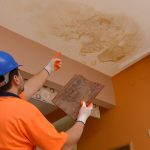What is Property Structural Damage?
Property structural damage is any damage that impacts your home’s core integrity, particularly your roof and walls. Your walls are integral to your home’s structure, and without them, your home would collapse.
Continue reading to learn about the causes of structural damage.
Causes of Structural Damage
Unfortunately, structural damage is inevitable. If your home is decades old, it probably has this damage due to natural wear and tear. However, natural disasters, such as strong winds and floods, are the primary cause of structural damage. Flood damage stress and wind gusts can undermine your home’s integrity by rusting and weakening foundational metal structures.
Most structural damage is noticeable, so you may be able to correct it before more harm occurs. Learn the three main signs of this type of damage below.
1. Foundation Cracks
Typically, your home’s upper walls attach to a crawlspace foundation by bolted plates or joints. We recommend using a flashlight to inspect this area. You probably won’t be able to see the footings or supports below your slabs, but you should look out for loose bolts and misaligned joints. However, you may be able to recognize common hairline cracks in your home’s concrete.
Be on high alert for large hairline cracks that are wide at the top and become narrow as they move downward; this indicates settling. Settling describes a building’s gradual sink into the ground, typically the result of shifting soil beneath your foundation.
Furthermore, if you spot horizontal cracks in a foundation backed into a hillside, it may indicate that your home is being pushed off its footings.
2. Leaning Structure
If your home’s doors and windows won’t open or close, its framework might be under too much stress due to slanting walls or uneven settling. Worst of all, if your home is leaning, it’s most likely out of your control; diligent construction workers factor in the settling of a home when they build it.
Cracks in your home’s walls and jarring doors and windows around framed-in features are red flags that indicate poor construction. If you notice these signs, your home will naturally begin to learn further or settle. We recommend looking at your home from your neighbor’s house or a nearby hill to see if its walls stand upright.
3. Decaying Joists
Joists spread across the tops of load-bearing walls and are supported mid-span by a beam. Check for rotting or bug-infested joints by poking your head through a dropped-ceiling panel and jabbing the wood with a sharp object, such as a screwdriver. It’s important to note that other damage, such as that caused by shifting, may or may not be a reason for alarm. For instance, even a newer home might have cracks due to expansion as the seasons change from cold to warm, and vice-versa.
Hudson Douglas Public Adjusters is Here for You
If you notice the signs of structural damage in your home or business, your first instinct may be to contact your insurance company. However, approaching them without working with a public adjuster is a mistake. Most insurance companies undervalue claims to their benefit.
At Hudson Douglas Public Adjusters, we represent you, not your insurance provider. We can help you settle your claim if it relates to structural damage caused by fire, smoke, floods, etc.
We’re licensed to offer services in Utah, Arizona, Colorado, Nevada, New Mexico, New Jersey, and Pennsylvania. Contact us today for a free claims review.




